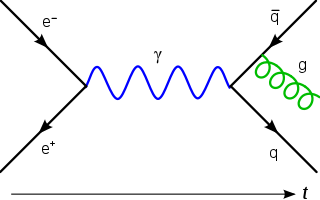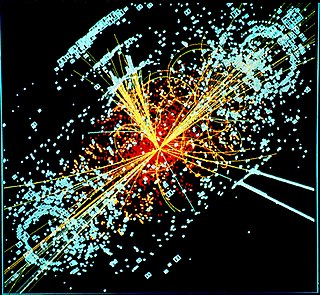
General relativity, also known as the general theory of relativity and Einstein's theory of gravity, is the geometric theory of gravitation published by Albert Einstein in 1915 and is the current description of gravitation in modern physics. General relativity generalises special relativity and refines Newton's law of universal gravitation, providing a unified description of gravity as a geometric property of space and time or four-dimensional spacetime. In particular, the curvature of spacetime is directly related to the energy and momentum of whatever matter and radiation are present. The relation is specified by the Einstein field equations, a system of second order partial differential equations.

Quantum gravity (QG) is a field of theoretical physics that seeks to describe gravity according to the principles of quantum mechanics. It deals with environments in which neither gravitational nor quantum effects can be ignored, such as in the vicinity of black holes or similar compact astrophysical objects, such as neutron stars as well as in the early stages of the universe moments after the Big Bang.
The following is a timeline of gravitational physics and general relativity.

In physics, an effective field theory is a type of approximation, or effective theory, for an underlying physical theory, such as a quantum field theory or a statistical mechanics model. An effective field theory includes the appropriate degrees of freedom to describe physical phenomena occurring at a chosen length scale or energy scale, while ignoring substructure and degrees of freedom at shorter distances. Intuitively, one averages over the behavior of the underlying theory at shorter length scales to derive what is hoped to be a simplified model at longer length scales. Effective field theories typically work best when there is a large separation between length scale of interest and the length scale of the underlying dynamics. Effective field theories have found use in particle physics, statistical mechanics, condensed matter physics, general relativity, and hydrodynamics. They simplify calculations, and allow treatment of dissipation and radiation effects.
In general relativity, Regge calculus is a formalism for producing simplicial approximations of spacetimes that are solutions to the Einstein field equation. The calculus was introduced by the Italian theoretician Tullio Regge in 1961.
Induced gravity is an idea in quantum gravity that spacetime curvature and its dynamics emerge as a mean field approximation of underlying microscopic degrees of freedom, similar to the fluid mechanics approximation of Bose–Einstein condensates. The concept was originally proposed by Andrei Sakharov in 1967.
Tests of general relativity serve to establish observational evidence for the theory of general relativity. The first three tests, proposed by Albert Einstein in 1915, concerned the "anomalous" precession of the perihelion of Mercury, the bending of light in gravitational fields, and the gravitational redshift. The precession of Mercury was already known; experiments showing light bending in accordance with the predictions of general relativity were performed in 1919, with increasingly precise measurements made in subsequent tests; and scientists claimed to have measured the gravitational redshift in 1925, although measurements sensitive enough to actually confirm the theory were not made until 1954. A more accurate program starting in 1959 tested general relativity in the weak gravitational field limit, severely limiting possible deviations from the theory.
Bruno Bertotti was an Italian physicist, emeritus professor at the University of Pavia. He was one of the last students of physicist Erwin Schrödinger.
In theoretical physics, a scalar–tensor theory is a field theory that includes both a scalar field and a tensor field to represent a certain interaction. For example, the Brans–Dicke theory of gravitation uses both a scalar field and a tensor field to mediate the gravitational interaction.
In theoretical physics, Whitehead's theory of gravitation was introduced by the mathematician and philosopher Alfred North Whitehead in 1922. While never broadly accepted, at one time it was a scientifically plausible alternative to general relativity. However, after further experimental and theoretical consideration, the theory is now generally regarded as obsolete.

In general relativity, post-Newtonian expansions are used for finding an approximate solution of Einstein field equations for the metric tensor. The approximations are expanded in small parameters that express orders of deviations from Newton's law of universal gravitation. This allows approximations to Einstein's equations to be made in the case of weak fields. Higher-order terms can be added to increase accuracy, but for strong fields sometimes it is preferable to solve the complete equations numerically. This method is a common mark of effective field theories. In the limit, when the small parameters are equal to 0, the post-Newtonian expansion reduces to Newton's law of gravity.
In classical theories of gravitation, the changes in a gravitational field propagate. A change in the distribution of energy and momentum of matter results in subsequent alteration, at a distance, of the gravitational field which it produces. In the relativistic sense, the "speed of gravity" refers to the speed of a gravitational wave, which, as predicted by general relativity and confirmed by observation of the GW170817 neutron star merger, is equal to the speed of light (c).
In physical cosmology and astronomy, dark energy is an unknown form of energy that affects the universe on the largest scales. Its primary effect is to drive the accelerating expansion of the universe. Assuming that the lambda-CDM model of cosmology is correct, dark energy is the dominant component of the universe, contributing 68% of the total energy in the present-day observable universe while dark matter and ordinary (baryonic) matter contribute 26% and 5%, respectively, and other components such as neutrinos and photons are nearly negligible. Dark energy's density is very low: 6×10−10 J/m3, much less than the density of ordinary matter or dark matter within galaxies. However, it dominates the universe's mass–energy content because it is uniform across space.

In cosmology, the cosmological constant problem or vacuum catastrophe is the substantial disagreement between the observed values of vacuum energy density and the much larger theoretical value of zero-point energy suggested by quantum field theory.

Entropic gravity, also known as emergent gravity, is a theory in modern physics that describes gravity as an entropic force—a force with macro-scale homogeneity but which is subject to quantum-level disorder—and not a fundamental interaction. The theory, based on string theory, black hole physics, and quantum information theory, describes gravity as an emergent phenomenon that springs from the quantum entanglement of small bits of spacetime information. As such, entropic gravity is said to abide by the second law of thermodynamics under which the entropy of a physical system tends to increase over time.

Superfluid vacuum theory (SVT), sometimes known as the BEC vacuum theory, is an approach in theoretical physics and quantum mechanics where the fundamental physical vacuum is considered as a superfluid or as a Bose–Einstein condensate (BEC).
In particle physics and physical cosmology, Planck units are a system of units of measurement defined exclusively in terms of four universal physical constants: c, G, ħ, and kB. Expressing one of these physical constants in terms of Planck units yields a numerical value of 1. They are a system of natural units, defined using fundamental properties of nature rather than properties of a chosen prototype object. Originally proposed in 1899 by German physicist Max Planck, they are relevant in research on unified theories such as quantum gravity.

Asymptotic safety is a concept in quantum field theory which aims at finding a consistent and predictive quantum theory of the gravitational field. Its key ingredient is a nontrivial fixed point of the theory's renormalization group flow which controls the behavior of the coupling constants in the ultraviolet (UV) regime and renders physical quantities safe from divergences. Although originally proposed by Steven Weinberg to find a theory of quantum gravity, the idea of a nontrivial fixed point providing a possible UV completion can be applied also to other field theories, in particular to perturbatively nonrenormalizable ones. In this respect, it is similar to quantum triviality.
Double copy theory is a theory in theoretical physics, specifically in quantum gravity, that hypothesizes a perturbative duality between gauge theory and gravity. The theory says that scattering amplitudes in non-Abelian gauge theories can be factorized such that replacement of the color factor by additional kinematic dependence factor, in a well-defined way, automatically leads to gravity scattering amplitudes. It was first written down by Zvi Bern, John Joseph Carrasco and Henrik Johansson in 2010 and was sometimes known as the BCJ duality after its creators or as "gravity = gauge × gauge".
Several hundred metals, compounds, alloys and ceramics possess the property of superconductivity at low temperatures. The SU(2) color quark matter adjoins the list of superconducting systems. Although it is a mathematical abstraction, its properties are believed to be closely related to the SU(3) color quark matter, which exists in nature when ordinary matter is compressed at supranuclear densities above ~ 0.5 1039 nucleon/cm3.



















